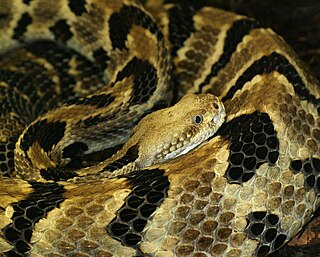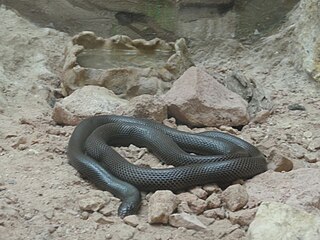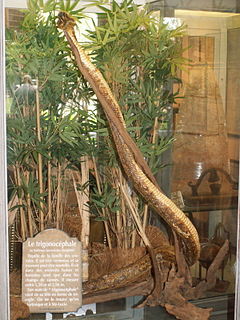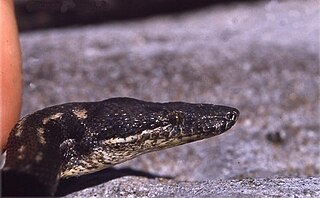
The Crotalinae, commonly known as pit vipers, crotaline snakes, or pit adders, are a subfamily of venomous vipers found in Eurasia and the Americas. They are distinguished by the presence of a heat-sensing pit organ located between the eye and the nostril on both sides of the head. Currently, 18 genera and 151 species are recognized: seven genera and 54 species in the Old World, against a greater diversity of 11 genera and 97 species in the New World. These are also the only viperids found in the Americas. The groups of snakes represented here include rattlesnakes, lanceheads, and Asian pit vipers. The type genus for this subfamily is Crotalus, of which the type species is the timber rattlesnake, C. horridus.

The Acrochordidae, commonly known as wart snakes, Java wart snakes, file snakes, elephant trunk snakes, or dogface snakes, are a monogeneric family created for the genus Acrochordus. This is a group of primitive aquatic snakes found in Australia and tropical Asia. Currently, 3 species are recognized.

The Typhlopidae are a family of blind snakes. They are found mostly in the tropical regions of Africa, Asia, the Americas, and all mainland Australia and various islands. The rostral scale overhangs the mouth to form a shovel-like burrowing structure. They live underground in burrows, and since they have no use for vision, their eyes are mostly vestigial. They have light-detecting black eye spots, and teeth occur in the upper jaw. The tail ends with a horn-like scale. Most of these species are oviparous. Currently, 18 genera are recognized containing over 200 species.

The Atractaspidinae are a family of snakes found in Africa and the Middle East, commonly called mole vipers, stiletto snakes, or burrowing asps. Currently, 12 genera are recognized.

Bothrops lanceolatus — known as the fer-de-lance, Martinican pit viper, and Martinique lancehead — is a species of pit viper generally considered endemic to the island of Martinique. No one has satisfactorily explained why it has flourished there but is unknown on nearly all other Caribbean islands. Some reserve the common name fer-de-lance for this species, while others apply that name to other Bothrops species as well. No subspecies are currently recognized.

The Leptotyphlopidae are a family of snakes found in North America, South America, Africa, & Asia. All are fossorial and adapted to burrowing, feeding on ants and termites. Two subfamilies are recognized.

The Aniliidae are a monotypic family created for the monotypic genus Anilius that contains the single species A. scytale. Common names include American pipe snake and false coral snake. It is found in South America. This snake possesses a vestigial pelvic girdle that is visible as a pair of cloacal spurs. It is ovoviviparous. It is non-venomous, and its diet consists mainly of amphibians and other reptiles. Currently, two subspecies are recognized, including the typical form described here.

The Bolyeriidae are a family of snakes native to Mauritius and a few islands around it, especially Round Island. They also used to be found on the island of Mauritius, but were extirpated there due to human influence and foraging pigs in particular. These snakes used to be placed in the Boidae, but are now classed as a separate family. Two monotypic genera are recognized, but only a single species is extant. Bolyeriidae appear to be most closely related to the Asian genus Xenophidion.

Leptotyphlops is a genus of nonvenomous blind snakes, commonly known as slender blind snakes and threadsnakes, found throughout Africa. 11 species have been moved to the genus Trilepida, others moved to the genera Epacrophis, Namibiana, Myriopholis, Epictia, Siagonodon, Tricheilostoma, Tetracheilostoma, Mitophis, and Rena.

The Boinae are a subfamily of boas found in Central and South America as well as the West Indies. Six genera are currently recognized.
Typhlops is a genus of blind snakes in the family Typhlopidae. The genus is endemic to the West Indies. Some species which were formerly placed in the genus Typhlops have been moved to the genera Afrotyphlops, Amerotyphlops, Anilios, Antillotyphlops, Argyrophis, Cubatyphlops, Indotyphlops, Letheobia, Madatyphlops, Malayotyphlops, and Xerotyphlops.
Helminthophis is a genus of non-venomous blind snakes found in southern Central America and northwestern South America. Currently, 3 monotypic species are recognized.

Chilabothrus is a genus of non-venomous boas found in the West Indies. 13 species are currently recognized.
Helminthophis praeocularis is a species of snake in the Anomalepididae family. It is endemic to Colombia.
Liotyphlops beui is a species of nonvenomous snake in the family Anomalepididae. It is found in northeast Argentina, eastern Paraguay, and center-west, southeast, and south Brazil; the Reptile Database restricts its range to Brazil. It is locally common in Brazil. It is sometimes known as the pale-headed blindsnake.
Liotyphlops ternetzii is a species of snake in the family Anomalepididae. The species is endemic to South America.

The big-scaled blind snake is a species of snake in the family Leptotyphlopidae. It has reported from Panama, Colombia, Ecuador, Venezuela, the Guyanas and Brazil.
Daboia is a genus of venomous vipers.













